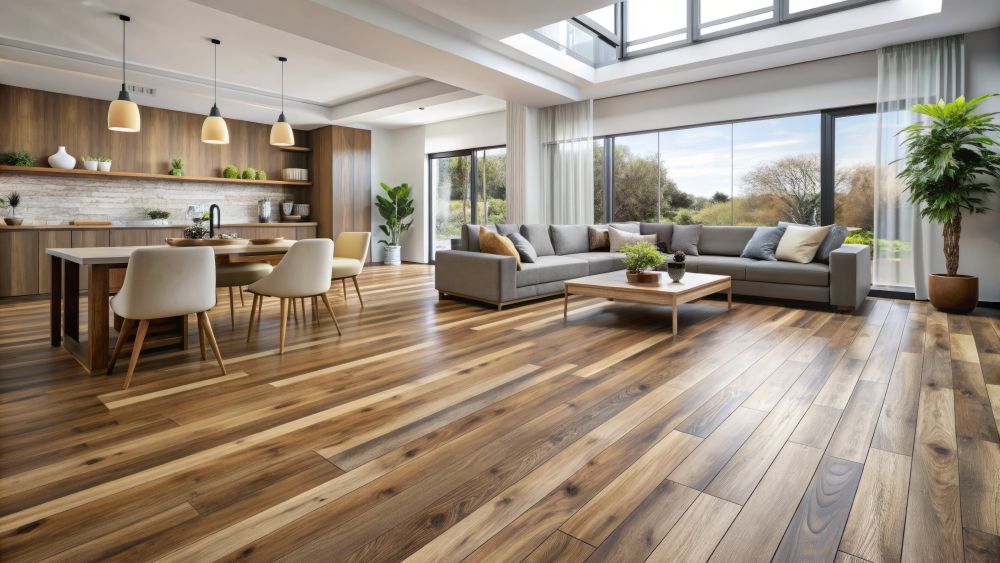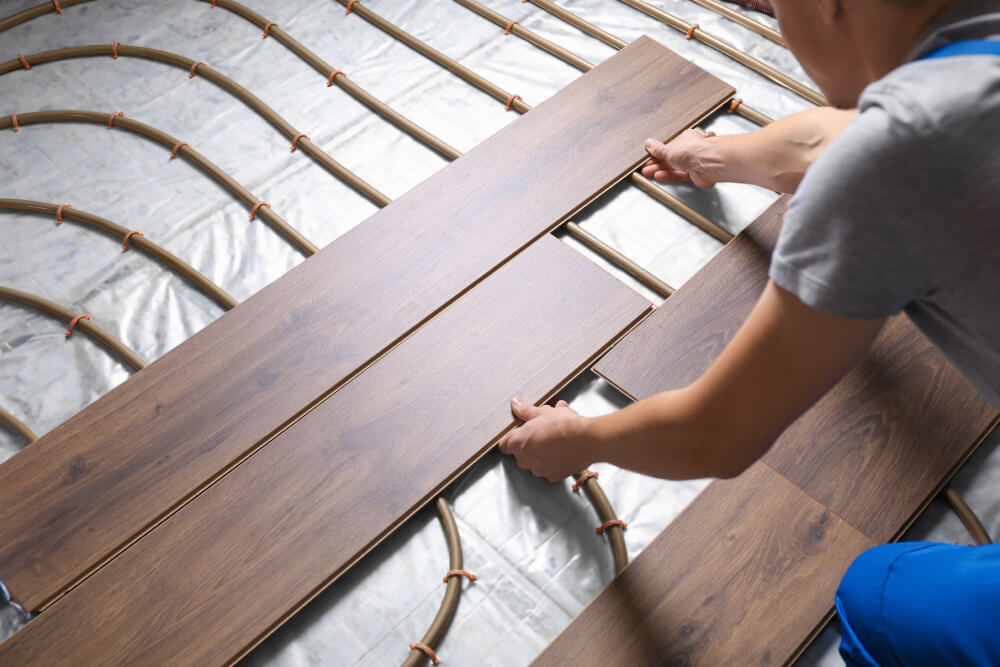Choosing the right flooring for your home can be a daunting task, especially with the wide range of options available. Two popular choices among homeowners are vinyl and laminate flooring. Both offer numerous benefits, but they also have distinct differences that can make one more suitable than the other depending on your specific needs. This comprehensive guide will compare vinyl and laminate flooring in terms of durability, cost, appearance, installation, and maintenance, helping you decide which is right for your home.
1. Understanding Vinyl and Laminate Flooring
Vinyl Flooring: Vinyl flooring is a synthetic product made from polyvinyl chloride (PVC) and other materials. It is available in several forms, including luxury vinyl planks (LVP), luxury vinyl tiles (LVT), and sheet vinyl. Vinyl flooring is known for its water resistance, durability, and ease of maintenance. Laminate Flooring: Laminate flooring is a multi-layer synthetic product made from wood byproducts and resin. It features a photographic layer that mimics the appearance of natural wood, stone, or tile, topped with a clear protective layer. Laminate flooring is valued for its affordability, ease of installation, and realistic appearance.2. Durability and Performance
- Vinyl Flooring:
- Water Resistance: One of the biggest advantages of vinyl flooring is its water resistance. Vinyl planks and tiles are waterproof, making them ideal for kitchens, bathrooms, basements, and other moisture-prone areas.
- Durability: Vinyl is highly durable and resistant to scratches, dents, and stains. It can withstand heavy foot traffic and is suitable for both residential and commercial use.
- Comfort: Vinyl flooring is softer and warmer underfoot compared to laminate, making it more comfortable for standing and walking.
- Laminate Flooring:
- Water Resistance: While laminate flooring is more water-resistant than traditional hardwood, it is not entirely waterproof. Prolonged exposure to moisture can cause the core layer to swell and warp.
- Durability: Laminate is also durable and resistant to scratches and stains, but it may not be as resilient as vinyl in high-moisture environments. However, it performs well in areas with moderate foot traffic.
- Comfort: Laminate flooring tends to be harder and cooler underfoot than vinyl, which can affect comfort levels, especially in colder climates.
Join HICP Homeowner’s Alliance
Connect with experts, get special discounts and enjoy member benefits
3. Cost Comparison
- Vinyl Flooring:
- Material Cost: The cost of vinyl flooring can vary widely depending on the type and quality. Luxury vinyl planks and tiles generally range from $2 to $5 per square foot, while sheet vinyl can be more affordable, ranging from $1 to $4 per square foot.
- Installation Cost: Professional installation for vinyl flooring typically costs between $2 and $5 per square foot, depending on the complexity of the job and the type of vinyl.
- Laminate Flooring:
- Material Cost: Laminate flooring is often more affordable than vinyl, with prices typically ranging from $1 to $4 per square foot. High-end laminate products can cost more, but they are still generally less expensive than luxury vinyl.
- Installation Cost: Professional installation for laminate flooring usually costs between $2 and $8 per square foot, similar to vinyl flooring. Laminate is also suitable for DIY installation, which can save on labor costs.
4. Appearance and Aesthetics
- Vinyl Flooring:
- Realistic Designs: Modern vinyl flooring can closely mimic the appearance of natural wood, stone, and tile, thanks to advanced printing technology. Luxury vinyl planks and tiles often feature realistic textures and patterns.
- Variety: Vinyl flooring is available in a wide range of colors, patterns, and styles, allowing homeowners to achieve almost any desired look.
- Seamless Installation: Sheet vinyl offers a seamless appearance, making it ideal for large areas where a continuous look is desired.
- Laminate Flooring:
- Authentic Look: Laminate flooring is known for its realistic appearance, with high-quality products often indistinguishable from real hardwood or stone. The photographic layer can replicate the look of various natural materials.
- Textured Surfaces: Many laminate products feature textured surfaces that add to the realism, providing a tactile experience similar to natural materials.
- Wide Range: Laminate flooring also comes in a diverse array of colors, styles, and finishes, making it easy to find a match for any decor.
5. Installation Process
- Vinyl Flooring:
- Ease of Installation: Vinyl flooring, especially luxury vinyl planks and tiles, is known for its ease of installation. Many products feature click-lock systems that make them suitable for DIY projects.
- Subfloor Preparation: Vinyl can be installed over various subfloors, including concrete, plywood, and existing flooring, as long as the surface is clean, dry, and level.
- Sheet Vinyl: Installing sheet vinyl can be more challenging due to its size and the need for precise cutting and fitting. Professional installation is often recommended for this type.
- Laminate Flooring:
- Floating Installation: Laminate flooring is typically installed as a floating floor, meaning it is not attached to the subfloor. Instead, the planks or tiles are interlocked, making it a popular choice for DIY installations.
- Underlayment: Laminate flooring usually requires an underlayment to provide cushioning, reduce noise, and improve moisture resistance. Some products come with pre-attached underlayment for added convenience.
- Subfloor Preparation: Similar to vinyl, laminate flooring can be installed over various subfloors, provided they are clean, dry, and level.
6. Maintenance and Care
- Vinyl Flooring:
- Cleaning: Vinyl flooring is easy to clean and maintain. Regular sweeping or vacuuming and occasional mopping with a mild cleaner are usually sufficient to keep it looking its best.
- Stain Resistance: Vinyl is highly resistant to stains, making it an excellent choice for households with pets, children, or high traffic.
- Repairs: Minor scratches and dents can be repaired with vinyl repair kits. However, damaged planks or tiles may need to be replaced, which can be relatively simple with click-lock systems.
- Laminate Flooring:
- Cleaning: Laminate flooring requires regular sweeping or vacuuming to remove dirt and debris. It should be mopped with a damp (not wet) mop and a laminate-specific cleaner to avoid water damage.
- Stain Resistance: Laminate is also resistant to stains, but spills should be wiped up promptly to prevent potential damage to the core layer.
- Repairs: Minor scratches can be addressed with laminate repair kits. However, more severe damage may require plank replacement, which can be more challenging due to the interlocking nature of the installation.
Conclusion: Choosing the Right Flooring for Your Home
Durability and Water Resistance: Vinyl flooring is the clear winner for areas with high moisture levels, such as kitchens, bathrooms, and basements. It is also highly durable and suitable for heavy traffic areas.Cost: Laminate flooring is generally more budget-friendly, both in terms of material cost and potential DIY installation savings.
Appearance: Both options offer realistic designs that can mimic natural materials. Laminate may have a slight edge in texture and authenticity, but vinyl provides excellent variety and seamless installation options.
Installation: Both vinyl and laminate are relatively easy to install, with click-lock systems making DIY projects feasible. Laminate’s floating installation is particularly user-friendly.
Maintenance: Vinyl flooring requires less maintenance and is more resistant to water and stains. Laminate needs careful cleaning to avoid moisture damage but is also low-maintenance overall.
Ultimately, the choice between vinyl and laminate flooring will depend on your specific needs, budget, and aesthetic preferences. By considering the pros and cons of each option, you can make an informed decision that enhances the beauty, functionality, and value of your home.








